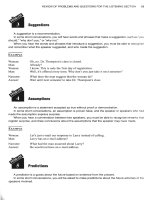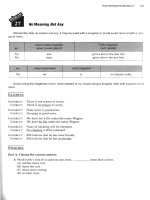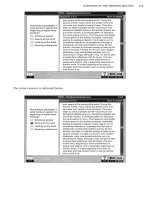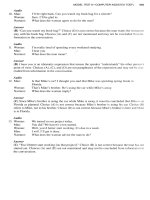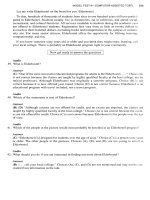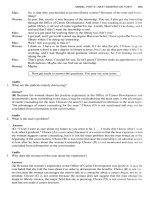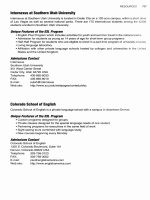How To End Phobias, Anxiety & Panic - part 4 doc
Bạn đang xem bản rút gọn của tài liệu. Xem và tải ngay bản đầy đủ của tài liệu tại đây (162.55 KB, 10 trang )
2. Behaviour Therapy
A classic approach to ending phobias, along with the attendant
anxiety and possible panic or anxiety attacks, is behaviour
therapy.
In essence, this consists of exposure to the feared object. You
do this in small steps, moving on to the next step only when
relaxed and comfortable enough with the earlier step.
Known as “systematic desensitization”, this process eventually
enables you to be completely unphobic about whatever it was
that you used to avoid, such as spiders.
It is not a pleasant procedure. But the boost to your self-esteem
and self-control is well worth the temporary discomfort.
(Guidance on how to choose a psychotherapist is available here:
A similar article about choosing the
right hypnotherapist is available at my Hypnosis Headquarters site).
3. Hypnotherapy
Hypnotherapy builds on the opposite reflex to the flight-or-fight
response that often paralyses the phobic person: relaxation.
With hypnosis you can deal with both the cause of the phobia
or panic attack (feeling abandoned at Aunt Susanna’s wedding)
and the symptoms (shortness of breath, sweaty palms, rapid
heartbeat, etc.)
Hypnotherapy changes the negative messages stored in your
subconscious, freeing you from the power of the anxiety.
During hypnotherapy you are awake and aware. You gain more
self-control.
The underlying cause for your phobia may be exposed while
you are in hypnosis. The dual nature of phobias a distraction
from an inner conflict and yet a signal that such a conflict exists
is well illustrated by Rebecca’s experience:
30
Rebecca sought hypnotherapy to deal with her fear of speaking at
business meetings. She is intelligent, resourceful, imaginative and
competent. Which is why Rebecca was in line to become a vice-
president at a prestigious company. However, her fear of speaking at
staff meetings and her terror at speaking at company functions or at
sales meetings with potential clients, threatened to block her
advancement.
In hypnosis Rebecca said her phobia served no purpose. But when she
imagined being at the nearly all-male board meetings her subconscious
indicated a different answer. Her fear was serving a purpose.
The subconscious was asked to provide an image of what that purpose
might be. Rebecca immediately saw her father and brother. What did
this image mean to the subconscious? “They’re men; I’m a woman.”
Out of hypnosis, Rebecca mentioned that she’d quit a previous
executive position because she earned more than her husband and he
couldn’t bear that.
It became clear that her phobia both pointed to, and distracted her from,
the notion that a woman should keep quiet in the presence of men.
Something, it turned out, she’d learned through the unintentional
behaviour of her father and brother.
Only a little hypnotherapy was needed to rid Rebecca of that self-
negating notion. Positive suggestions cemented what her conscious
mind already knew she had as much (in some cases more) right to
speak as did her male colleagues.
4. Psychovisual Therapy [PsyV]
This self-help approach is available on hypnotic video and
DVD.
Two PsyV titles [
/>] that can help you
overcome panic attacks are “Stress Control” and “Relax & Let
Go”. “Self-Confidence” has also proven useful when low self-
esteem underlies a phobia.
(I’m the distributor of these cost-effective
DVDs and videos.)
31
5. Emotional Freedom Techniques [EFT]
Swift relief is usually available — and permanent — w
approach. Very different to the t
ith this
herapy techniques described
above, Emotional Freedom Techniques are a form of
either adding
EFT to their practices, or switching entirely to this combination
For full information, including examples of people erasing their
hobias, click here:
acupuncture, without needles.
Many psychotherapists and hypnotherapists are
of Western psychology and Chinese medicine.
p
32
Self-Help Cure
You can put an end to your phobias, anxiety and panic attacks
ause even without a therapist, you can combine the
five solutions mentioned above. Your own personal, powerful
anic-free, relaxed and confident.
ise that the power to change lies with you.
tional
Freedom Techniques you can at the least reduce anxiety and
r.
Go here for simple instructions on how to use EFT:
yourself.
That’s bec
antidote.
This can result in you being p
Here’s how to cure yourself:
First of all, recogn
And no one else.
The first step is to decide to be rid of whatever bothers you.
The second is to accept that, one way or another, you’ll have to
face the fear to overcome it. But, if you begin with Emo
fear. And, at best, remove the phobia or panic foreve
Essential to success with EFT is that you zero in on what really
nd
completely accept myself”, while another person will say,
I’m worried about panicking in the plane’s toilet,
I deeply …”, or “Even though I’m concerned about the stale air,
I deeply …”
bothers you.
For instance, one person who fears to fly will say, “Even
though I am terrified the plane will crash, I deeply a
“Even though I feel I’m not in control, I deeply…”
It’s also important to tap on each aspect that bothers you.
So, for example, the people afraid to fly might also tap on
“Even though
33
It also helps (as with any method of change, including
hypnosis) to add the element of choice to your self-statements.
“Even though I’m scared to enter the mall, I choose to be calm,
confident, relaxed and strong…”
With or without EFT, essential to freeing yourself from fear and
anxiety is to alter the way you think. We alluded above to
stopping catastrophic thinking.
Similarly, the anxiety-prone person engages in what Albert
Ellis, the guru of Rational-Emotive Therapy, calls
“mustobatory thinking.”
Examples of such destructive thoughts are:
I MUST know precisely why I’m feeling like this;
I MUST be certain it’s not serious;
I MUST never lose control or act crazily;
I MUST not do something stupid or look foolish;
I MUST have a guarantee I’m not going to die;
I MUST not make myself panic.
If you find yourself having MUST thoughts know that such
extreme statements only serve to make you feel worse.
Let go of the pressure of MUST thinking. You can do this with
rational thought, and by re-programming your subconscious.
To change your conscious negative thinking question your
MUST thoughts in the same way you challenge your
catastrophic thoughts.
For instance, “I must not do something foolish or look stupid.”
Tell yourself, “So what if I do something silly. It’s no big deal.”
You can also remind yourself that most people are preoccupied
with themselves – they don’t really care if you do something
you think is foolish.
34
While tapping with EFT, you’d challenge this fear with an
affirmation like “Even though I’m afraid I’ll do something
stupid or foolish, I deeply and completely accept myself.”
With hypnosis you’d use a positive suggestion such as “I
choose to enjoy letting go of upsetting thoughts.”
Hypnosis is the way to re-program your subconscious.
Detailed instructions on how to use hypnosis to let go of
anxiety and of fears that impede your life, are spelled out in my
ebook , “Self-Hypnosis: Safe. Simple. Superb.”
[
/>]
How would you use behavioural techniques to change your
fear of “doing something stupid or foolish”?
You’d deliberately do something “stupid or foolish.”
But start small. Remember the film “What About Bob?” in
which Richard Dreyfuss plays the part of an inept psychiatrist?
His patient takes literally Dreyfuss’ advice to “take baby steps.”
That’s how you tackle the fear of doing something stupid or
appearing foolish. If you are afraid of dancing, for example,
you don’t just jump on a stage somewhere and perform in
public.
Create a list of what frightens you, from the least frightening to
the most.
For the dancing example, perhaps looking at photographs of
dancers is the least anxiety-provoking. So you begin there. Use
your slow-deep breathing and thought-stopping until you’re
totally comfortable, then move up to the next item on your list.
Perhaps that is reading biographies of dancers. Then you could
take a class in the easiest form of dancing. Gradually work up
to whatever kind of dancing you aspire to.
35
Talking about dancing reminds me that I used to be much too
shy to dance at social functions. (Incidentally, shyness is the
height of egoism: so focussed on oneself that you think
everyone else is, too!).
However, several years ago at a social function with my new
wife I had to either hold on to my phobia and displease my
beloved, or face the challenge and go on to the dance floor with
her.
Fortunately I chose the latter. And this despite my silly fear of
looking foolish. As it turned out, my wife’s pleasure at my
fumbling attempts to dance freed me to be more and more
relaxed.
Not that I became an expert. But the important point is that this
small step (literally) enabled me to subsequently enjoy dancing
with my wife in public.
To Sum Up
You can rid yourself of your phobia, anxiety or panic.
1. Make the decision to change.
2. Substitute rational thinking for irrational.
3. Gradually face the fear(s).
4. Develop appropriate EFT and/or hypnosis skills.
5. Reinforce changes with books, videos, DVDs, CDs or
audiotapes.
I’d be happy to hear about your progress.
Email me at
mailto:
36
About Dr Bryan Knight
Bryan M. Knight, MSW, PhD, holds a degree in psychology
from Sir George Williams University, a Master's in social work
from McGill University and a doctorate in counselling from
Columbia Pacific University for his dissertation, Professional
Love: The Hypnotic Power of Psychotherapy.
His 37 years in private practice have taught him to appreciate
the uniqueness of each individual, and how to strengthen the
client's positive values. Dr. Knight is the author of numerous
articles and several books, including
The People Paradox;
Enjoying Single Parenthood;
Love, Sex & Hypnosis: Secrets of Psychotherapy;
Health and Happiness with Hypnosis.
And these ebooks:
Hypnosis: Software for Your Mind;
SELF-HYPNOSIS: Safe, Simple, Superb;
How to Get Started as a Hypnotherapist;
How To Avoid a Bad Relationship;
Easily Hypnotize Anyone, and
Marketing Action Plan for Success in Private Practice.
Dr. Knight, a certified hypnotherapist, has frequently been a
speaker at the National Guild of Hypnotists. Consulting
Hypnotherapist to the Westside Medical Clinic in Montreal, he
is also the distributor of Psychovisual Therapy DVDs and
videos.
Dr Knight created The International Registry of Professional
Hypnotherapists. And The Global Directory of Hypnosis
Training.
He introduced Emotional Freedom Techniques to Canada. He
can be reached by e-mail at
mailto:
,
by
37
regular mail at 7306 Sherbrooke Street West, Montreal, QC,
Canada, H4B 1R7, and by phone at (514) 332-7902.
38
Resources
Anxiety Network
/>
Emotional Freedom Techniques
/>
ABIL: Agoraphobics Building Independent Lives
/>
Dental Phobia and Anxiety
/>
National Phobics Society
/>
Rational-Emotive Therapy
/>
Social Phobia/Social Anxiety Association
/>
Anxiety Disorders Association of America
Women Helping Agoraphobics, Inc.
NAMI (National Alliance for the Mentally Ill)
National Institute of Mental Health
Self-Help book for Anxiety/Panic Problems
/>
Description of various psychotherapies
/>
39


